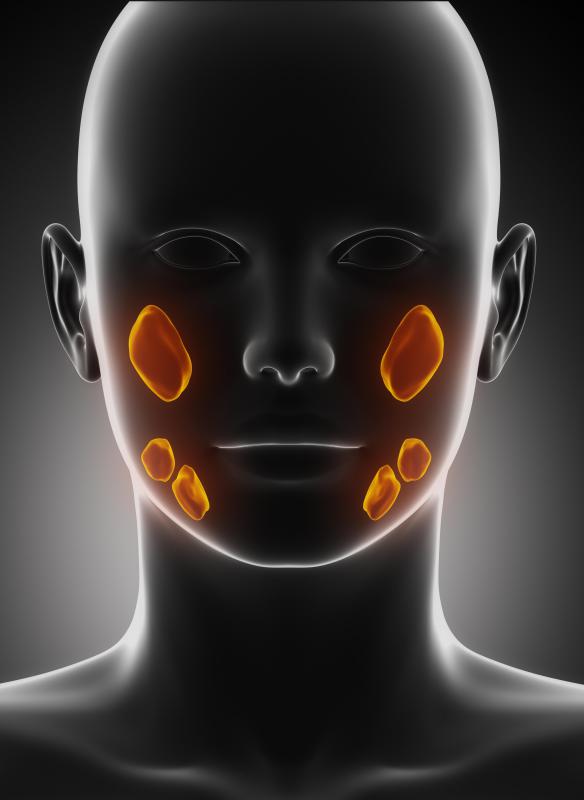At WiseGEEK, we're committed to delivering accurate, trustworthy information. Our expert-authored content is rigorously fact-checked and sourced from credible authorities. Discover how we uphold the highest standards in providing you with reliable knowledge.
What are Parotid Tumors?
Parotid tumors are abnormal growths of tissue in the parotid gland — the largest of three major pairs of salivary glands in the mouth and throat. The parotid glands secrete saliva into the mouth, thereby making it easier to chew, swallow, and digest food. One gland is situated below each ear, beneath the jawbone. Tumors of the gland typically increase its size but tend to grow rather slowly. When parotid tumors are diagnosed as malignant, they can usually be successfully treated.
Salivary gland tumors are generally quite rare, typically occurring in as few as one in 33,000 people each year. When such tumors do develop, however, they usually manifest themselves as parotid tumors. About 80 percent of parotid tumors are normally diagnosed as benign, or noncancerous.

The first symptom of a parotid tumor is often swelling of the gland, noticed as a hard bump below the ear. Enlargement is typically accompanied by little or no pain. Since the facial nerve runs through the parotid gland, pressure on the nerve may eventually result in an additional symptom — some degree of difficulty in moving the muscles of the face on the side of the affected gland.

Tests to see if a tumor is benign or cancerous typically begin with a biopsy to examine tissue, usually in the form of a fine needle aspiration (FNA). If additional tests are needed for diagnosis, they generally consist of one or more imaging studies using x-rays, computed tomography (CT), magnetic resonance imaging (MRI), or positron emission tomography (PET) scans. When a malignancy is detected, further imaging studies are sometimes conducted to determine if cancer cells have spread to the lymph nodes.

Whether parotid tumors are malignant or benign, the primary treatment option is normally surgical removal of the tumor. The surgery usually involves some risk of after effects since the surgeon must cut around the easily damaged facial nerve. Candidates for this surgery are generally advised to ask their surgeons for an assessment of possible facial nerve damage and its consequences.

For cases where a cancerous tumor appears to be particularly aggressive or has already spread to the lymph nodes, the surgeon may also remove the lymph nodes. Such surgeries are frequently supplemented with radiation therapy. In rare instances when chemotherapy is used to treat malignant parotid tumors, its use is generally limited to shrinking the tumors to reduce pain.

Even when parotid tumors have been diagnosed as malignant and the lymph nodes are involved, the cancer is usually curable. Curability of cancer is assessed in terms of five-year survival rates. Even for malignant parotid tumors in which cancer has spread to the lymph nodes, survival rates ranging up to 85 percent can typically be expected following treatment.
AS FEATURED ON:
AS FEATURED ON:
















Discussion Comments
For about 11 months I have been complaining of a lump below my ear by the jaw bone. It gets big then seems to vanish. It never hurt until my Chiropractor began using the Activator on it. I no longer see my Chiropractor.
In Nov of 2014 I got a cold from my grand daughter and have not had a cold since 1994. This cold and cough lasted about six months. I kept telling my doctor about this lump and he felt it and said 'oh it's just a swollen gland. ' I bought it at first but as time went by and it kept coming and going I began to become quite concerned.
Finally, he ordered a CT Scan (this was in the ninth month) and when I got the results, he said, 'It's just an enlarged gland.' I walked out of his office feeling so relieved finally! Then I got my eighth sinus infection and went back to the doctors. I saw someone else this time and she really examined me and looked in my throat, put me on Antibiotics and said she wanted me to see an ENT and surgeon. So I saw the ENT. The surgeon would not see me only because he does not do surgery on the neck.
Anyway, the ENT examined me, said my sinuses looked OK but that I had a tumor in the paratoid. My concerns were several, say doubtful for tumor, while others say as I suggested, it's a stone in the parotid - without proper testing it is hard to tell. The ENT is nice but seems a bit in a rush to do surgery before anything has been done or biopsied. Any comments with truth and reassurance would be greatly appreciated.
Post your comments